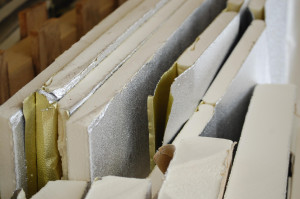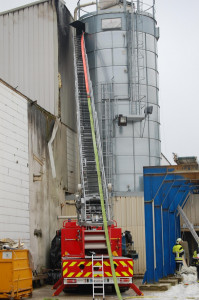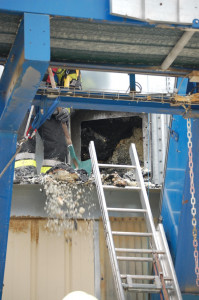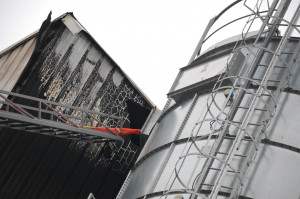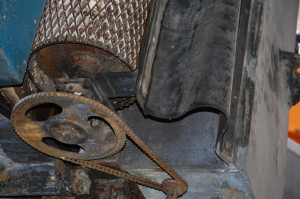Fire broke out in a 60-m³ silo, half filled with polyurethane dust, inside a plastic insulation panel factory. Around 2 pm, an explosion occurred in the vicinity of a polyurethane panel crusher. The spreading of this debris into the silo raised the pressure capacity and one of the 4 vents gave way, causing a 2nd blast. A fire outbreak followed, accompanied by a release of smoke and gases, including carbon monoxide (CO) and hydrogen cyanide (HCN). The alarm sounded at 2:05 pm; 80 employees were evacuated. The internal emergency plan was launched. The site’s first response teams installed a fire hose and at 2:15 pm called the city’s fire department. They arrived between 2:30 and 2:45 pm. The silo’s utility lines were shut down and the storm drain network closure valves activated.
At 3:30 pm, first responders evacuated the surrounding industrial and commercial zone (26 individuals in all) and confined 500 neighbours. A safety perimeter was set up enclosing the site. Fire-fighters, wearing self-breathing apparatuses, cooled the silo with water hoses. Foam was injected from above. The company did not possess any drawings of the silo. A maximum HCN concentration of 4 ppm was recorded, vs. an exposure limit value (ELV) of 1.9 ppm. Extinguishing water overflowed the retention basin yet remained confined to the site, with the impermeable exterior courtyard serving as a retention device. At 7 pm, utility lines were restored and one production line could be restarted. The fire was extinguished at 10 pm, and by 1 am another line was placed back into operation. During the response, one fire-fighter felt the ill effects of CO exposure. Equipment received from other departments made it possible to assemble an HCN measurement network across the zone.
At around 10 am the next morning after opening the hatch, fire-fighters wearing self-breathing gear drained the silo from the bottom, before being relieved by a private firm. Inspectors of classified facilities visited the site. First responders left the scene at 8 pm.
On-site damage was limited: workshop cladding was darkened by the smoke; the crusher was slightly damaged and the silo could be salvaged. All production lines, which were suspended for a few hours, had remained intact and were started back up on 15 November.
The silo responsible for this accident had been receiving 2 types of polyurethane sawdust waste: fine machining dust suctioned and treated in a sleeve filter before conveyance to the silo; and coarser sawdust suctioned from a plate crusher and intended for a disposal located right next to the silo (20-m suction pipe length between crusher and silo). This very lightweight dust amounted to 450 kg of the total 30 m³ on hand. With this particular layout, it was highly unlikely that the fine machined dust was at fault (given the intermediate filtering stage, the suction length and the lack of metal parts). The crusher would be to blame since it showed marks from the fire, coupled with the fact that the crushed plates might have contained an aluminium layer, i.e. a potential ignition source. Moreover, the crushing of these plates released pentane, capable of igniting for example when heating the crusher. These plates have been a regular cause of fire in storage cells during crushing operations.
Once the accident had been appraised, the causes assigned were a defective suction system at the crusher outlet, which in turn raised the pentane concentration, associated with the presence of an unidentified foreign metal object that heated in contact with the crusher rotor followed by sparking to ignite the pentane.
The silo operator introduced a spark detection / automated water extinction system. Other initiatives were adopted as well: installation of pentane and CO detectors connected to a measurement control station capable of automatically shutting off equipment; creation of a system to facilitate removal of crushing residue “cakes” to avoid their accumulation under the crusher rotor; and verification of the fan’s proper operations to ensure suction with a dependence on the crusher regime. The panel conveyor belt and feed roller on the crusher were motorised, and the rotor was redesigned to replace the cutting-shredding unit. To prevent the crushing of waste panels with an aluminium cladding, it was planned to dispose of them directly into a skip after production; if the skips were full, a storage zone was to be allocated across from the crusher. Moreover, a poster placed near the crushing station reminded technicians that it was prohibited to crush these easily-identified panels, as opposed to the cladding-free variety.
With the implementation of these measures guaranteeing the crusher’s good working order, the inspection authorities for classified facilities authorised the silo restart on 16 April 2013.



